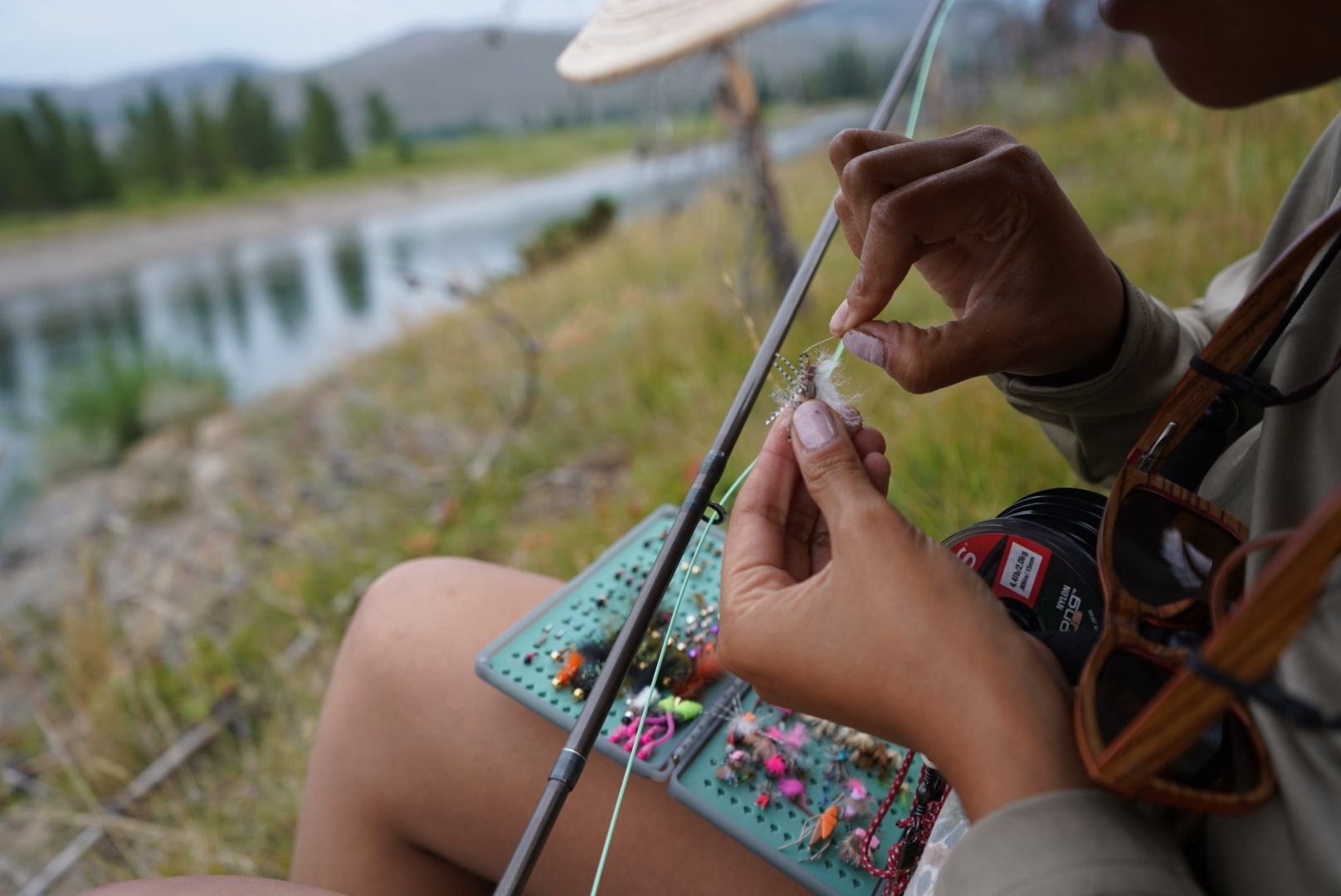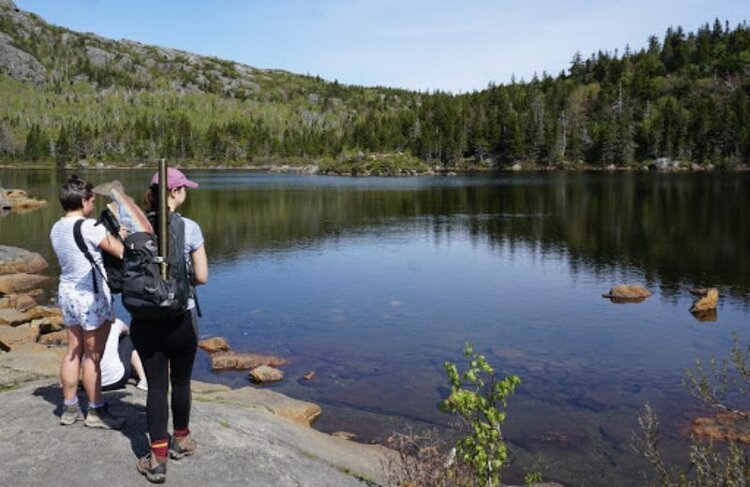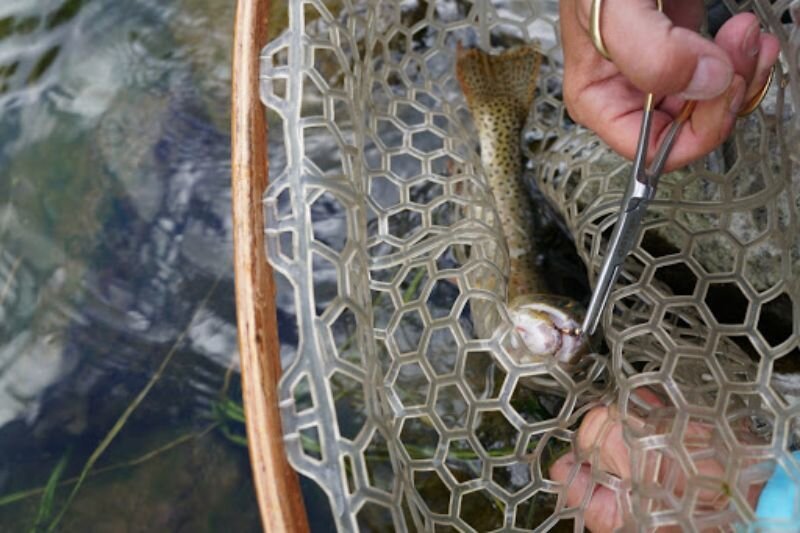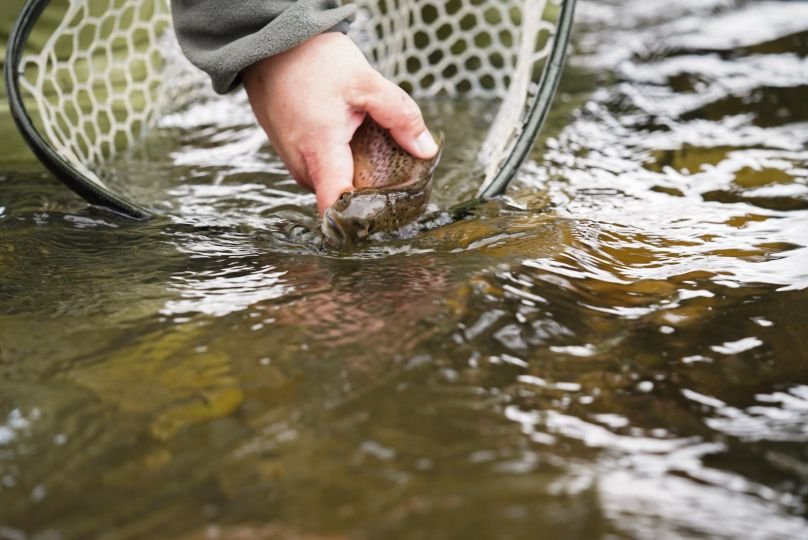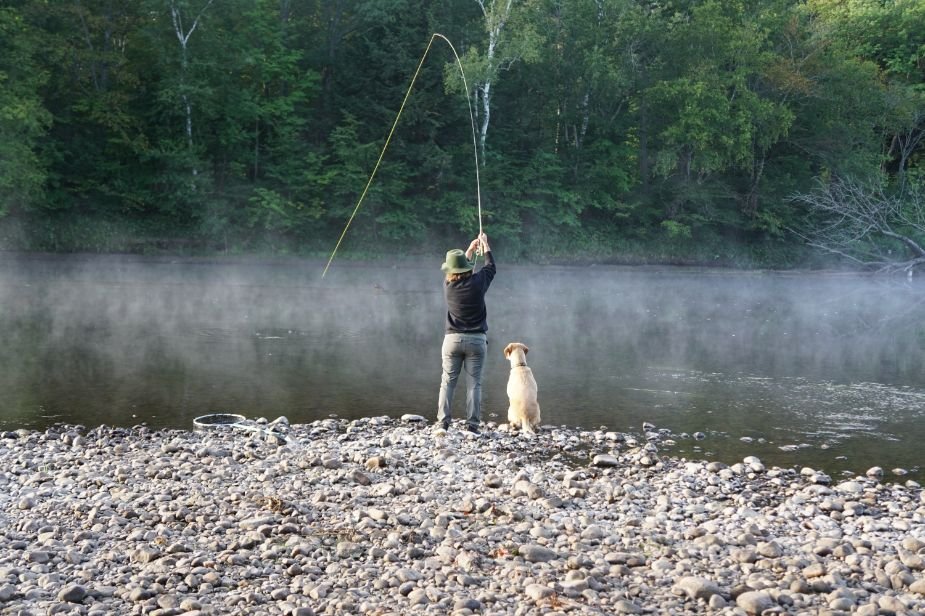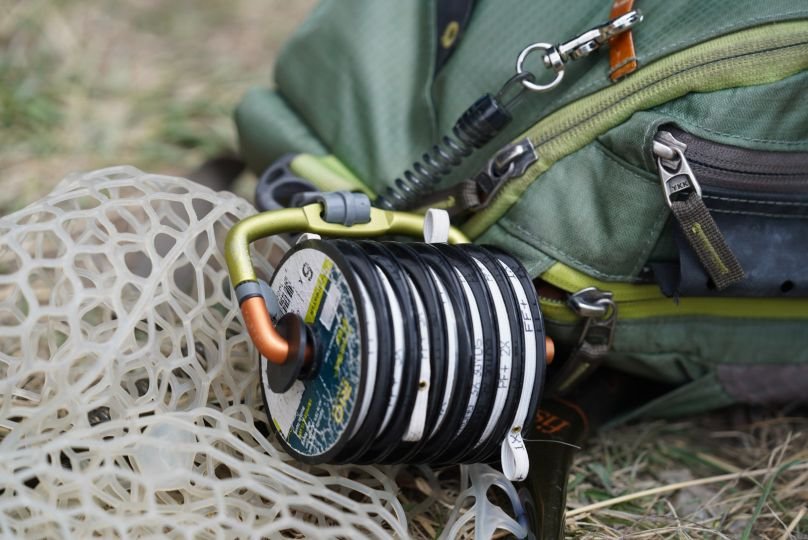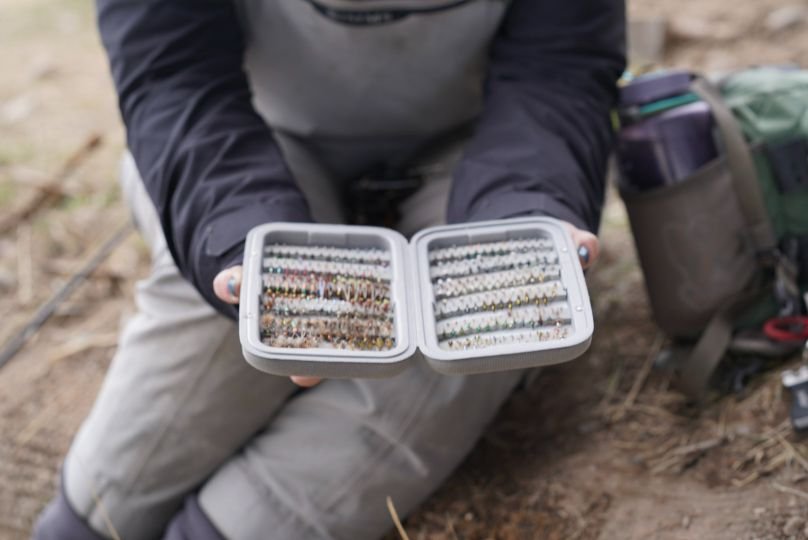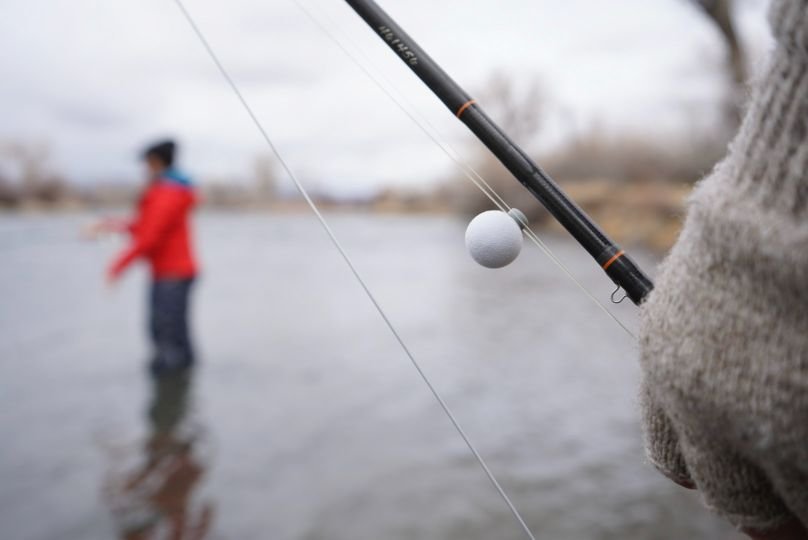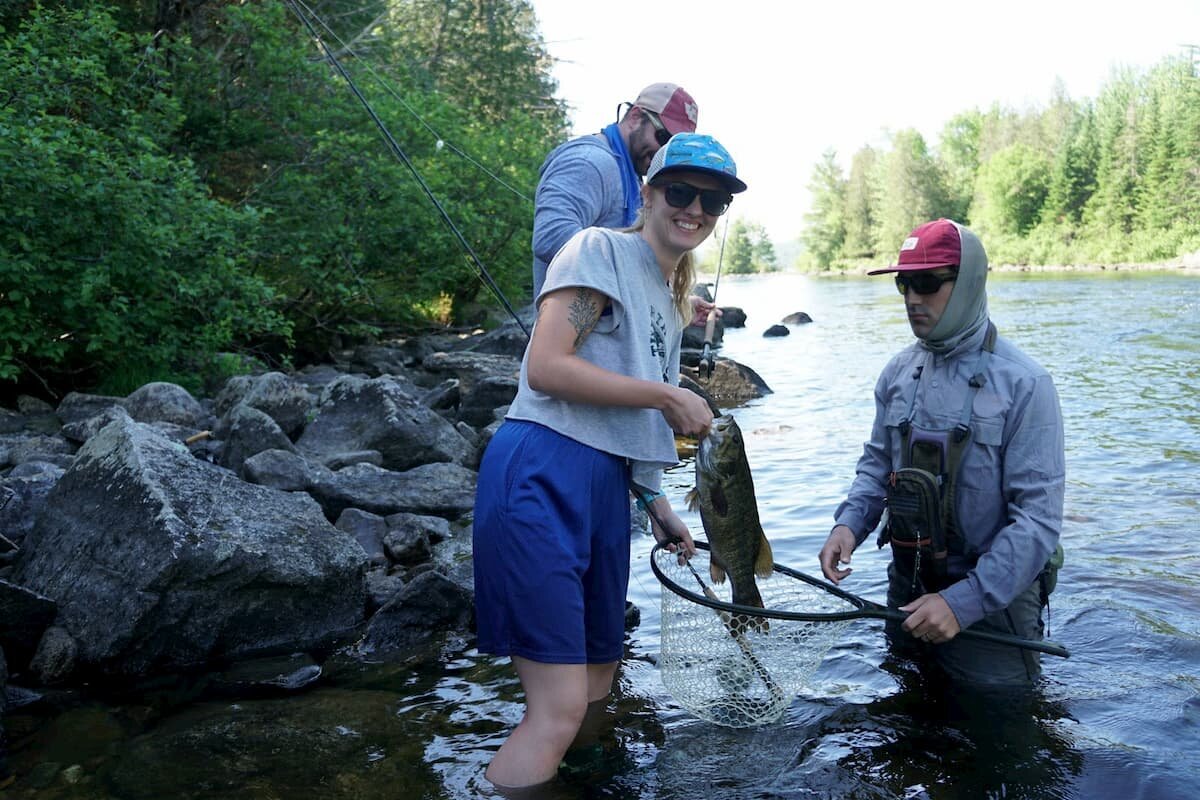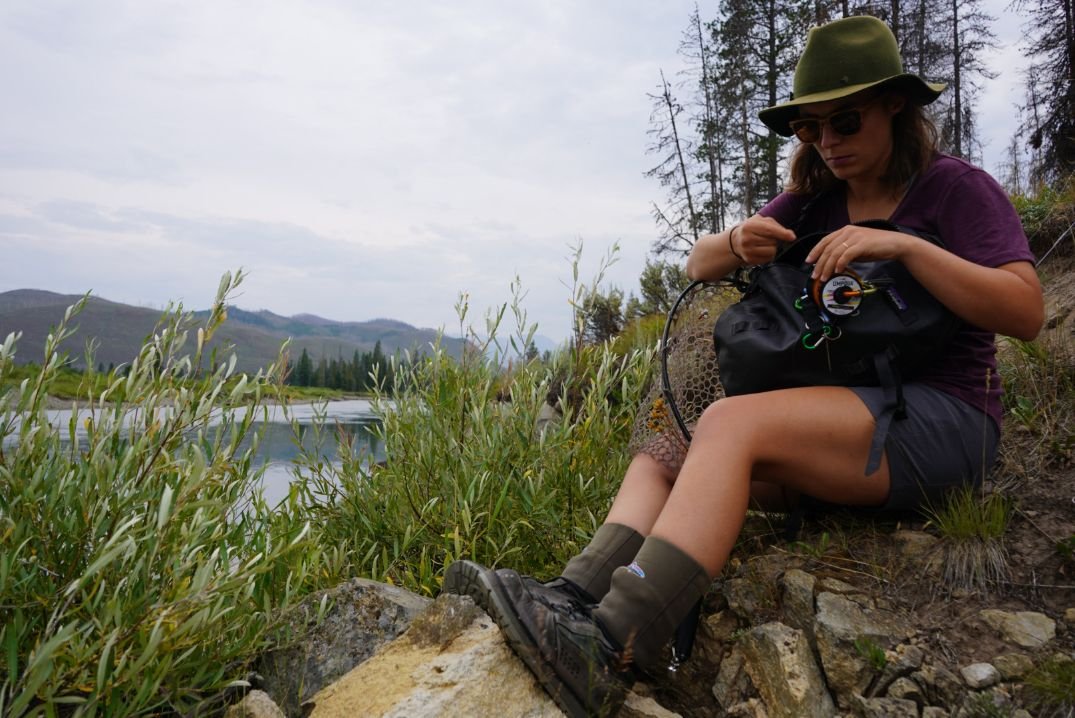Fly fishing accessories: Must-have tools for every angler
essential fly fishing gear: tools and accessories to build your own fly fishing kit
May 10th, 2024
Home > Gear Lists > Water Sports
While our recommended fly fishing rod and reel beginner kits include most of what you need to get started fly fishing, the fly fishing accessories in this article will help you be prepared for changing flies, packing refreshments, and getting around.
I'm an avid fly fisher and President of the Grand Valley Anglers Chapter of Trout Unlimited and on the Equity Working Group for Colorado Trout Unlimited. As a paraplegic fly fisherman, I'm intimately familiar with the difficulties faced by individuals with physical disabilities in accessing fishing. I work with groups like Project Healing Waters Fly Fishing, teaching fellow disabled veterans how to fly fish, tie flies, and build rods. Knowing what to bring–including fly fishing accessories–is essential to learning how to get out there.
I co-wrote this with Bri Dostie, who runs Confluence Collective, and wrote our Beginner Fly Fishing Combos article. Bri is a registered Maine Recreation and Fishing Guide, Founder of Confluence Collective, winner of Orvis's Breaking Barriers award, and an avid angler.
Since I don't wade, Bri also writes about wading accessories, including waders and wet wading gear. She's focused on building an inclusive fishing community — and sharing what fly fishing gear to pack for a trip helps remove some barriers to fly fishing.
We create reader-supported, objective, independently-selected gear reviews. This story may contain affiliate links, which help fund our website. When you click on the links to purchase gear, we may get a commission — without costing you an extra cent. Thank you for supporting our work and mission of outdoor coverage for every body! Learn more.
FLY FISHING ACCESSORIES CHECKLISTS
BEGINNER Accessories — FIRST TRIP
| GEAR ITEM | PRODUCTS WE LIKE |
|---|---|
| Leaders | |
| RIO | |
| Scientific Anglers | |
| Tippet | |
| All types at Backcountry |
BEGINNER ACCESSORIES — SECOND TRIP
| GEAR ITEM | PRODUCTS WE LIKE |
|---|---|
| Lanyard | |
| Morning Star Lanyards | |
| Orvis Lanyard | |
| Tippet Holder | |
| RIO Headgate Powerflex Tippet Holder |
INTERMEDIATE AND ADVANCED FLY FISHING ACCESSORIES
| GEAR ITEM | PRODUCTS WE LIKE |
|---|---|
| Wearable Fishing Rod Holder | Fishpond Quikshot 2.0 |
| Nail Knot Tool | |
| TIE-Fast | |
| Scientific Angler Tie Fast Knot | |
| Strike Indicator | Oros Fly Fishing |
While there are fly fishing-specific pack options, whatever backpack or dry bag you have or can borrow is enough to keep your things together and get out on the water. Photo courtesy Bri Dostie.
First Trip Must-Haves
These fly fishing accessories are essential — even if you're going out for the first time. Some of these items are included in beginner fly rod and fly reel combo kits, so you may not need to purchase them separately at first. Others may be easy to borrow when fishing with others or if you're on a guided trip but are things you will definitely be using on your first day of fly fishing.
Don't forget to pack the right clothes and footwear. See our section below on What to Wear.
LEADERS
A leader is a translucent, less-obvious fly fishing line that connects to the fish-end of your fly line, allowing an angler to cast a fly onto the water in a more camouflaged way.
While most of the beginner kits we reviewed include a leader, you’ll inevitably make it shorter and shorter as you change flies (or need to change leaders for different fishing conditions).
There is a range of leaders available from brands like Rio and Scientific Anglers, and they vary in length and strength depending on what species you are targeting and under what conditions. Talk with your fly shop or search for leaders based on where you’ll fish, under what conditions, and how big the fish you plan to catch might be.
RIO
SCIENTIFIC ANGLERS
TIPPET
Tippet is like an extension for your leaders. Unlike the leader itself, which starts about the same diameter as your fly line and tapers to very thin, tippet is available in specific diameters to tie on to your leader. It’s a good option for extending the life of a leader.
If you don’t want to buy all tippet diameters at first, go for something midrange, like 4x to start, which is the tippet I frequently run out of on the water. The 4x diameter suits delicate presentations on clear, still water and more turbulent, strong currents with bigger flies.
Ask questions about what tippet might work best on your local water. Are there lots of clean and clear creeks? You’ll probably need something smaller than 4x to avoid spooking fish. Plan to fish raging rivers? Something bigger than 4X might better stand up to stronger currents.
Want everything at once? Backcountry and other retailers offer packs running the gamut of tippet diameters; they even include a handy organizing clip.
NIPPERS
Please, don’t bite your line! Spare yourself the dentist trip and get nippers — a fancy word for line clippers.
You’ll need nippers whenever you change flies or tie knots in your leader or tippet. They can be as simple as $0.99 nail clippers (works great for your first trip!) or specialized options from fly fishing companies like this option from Lid Rig (an investment for once you are "hooked" on fishing).
I really enjoy the Lid Rig because it has magnets and a special hat clip that it attaches to. The clip doubles as a file for sharpening the nippers, too. I am sponsored by Lid Rig, but they're so convenient — they genuinely are the nippers I would choose and use even if I wasn’t affiliated with them.
Another great option is the Simms Freestone nippers, which have a simple design, aren't expensive, and have an area on the back to clip to your lanyard to hang around your neck.
If you get only one fly fishing accessory before your trip, have it be nippers (or some nail clippers).
You can also get your nippers as part of a bundle essentials pack that includes nippers and a zinger (a retractable lanyard used to hold your tools).
SIMMS FREESTONE NIPPERS
UMPQUA DREAM STREAM NIPPERS
LOON OUTDOORS ROGUE NIPPERS
Forceps help remove small or deeply lodged flies from fish, especially smaller fish. If you want to take extra steps towards smooth dehooking, crimp the barbs on your flies or get barbless hooks, as these can be removed more easily. Photo courtesy Bri Dostie.
FORCEPS
Forceps help remove hooks from fish, especially if the fly has been swallowed or is stuck in the fish’s mouth. The forceps you see in angler’s hands range from fancy fly fishing company options such as these from Loon Outdoors to forceps you might find in a first aid kit (often referred to as hemostats), though you can also use a multi-tool or pliers.
Forceps can also be used to push down the barb that is present on some fly fishing hooks. We do this to make it easier for the hook to be removed from the fish’s mouth while causing as little permanent damage as possible to the fish for those wanting to practice catch and release fishing. For those that intend to harvest a fish, they may want to leave the barb in place.
There’s no need to splurge on this tool to get started. This pair is less than $10. But you’ll be grateful to have it around when removing a small fly from a slippery subject.
LOON OUTDOORS FORCEPS
EAGLE CLAW FORCEPS
FLY FLOATANT
Fly goop, dry fly solution — whatever you call it, floatant helps keep your dry flies on the surface of the water instead of below the film (the area of water just below the surface’s tension) and out of sight.
Since flies are made of thread, fur, and feathers, most are made to float effortlessly. But after hours of resting on liquid and exposure to water currents, your fly will inevitably begin to sink. Fly floatant is an extra step in the process, but it helps keep your dry flies drier.
I usually keep two different types of flotant to use while fishing. The first is a pretreatment that you apply to your fly before you start fishing. There are several types to choose from, such as Aquel from Loon Outdoors.
I also carry a powder floatant that is generally used after your fly has been used for a while and you notice that it is no longer floating on the surface as it should. Typically this occurs when your fly gets fully submerged for more than 5-10 seconds, like when you catch a fish, and they pull it under!
Liquid-based floatants, like Fly Agra, generally do not work as well on wet flies, so a powder-based floatant is needed to adhere to the wet fly body and dry it out. Again there are many options to choose from, such as Loon Outdoors Top Ride, which we like because the company is working to reduce single-use plastic and other waste that can end up in waterways.
If you aren't dry fly fishing or don’t mind drying out flies by using a cloth or fluffing them manually, skip this purchase.
LOON OUTDOORS AQUEL FLOATANT
LOON OUTDOORS TOP RIDE POWDER FLOATANT
A brown trout rests in the basket of a silicone net before release. Nets can help cut down on fighting time with a fish on the line and cut back on contact with the fish to keep their protective slime intact and result in better survival rates. Photo courtesy Bri Dostie.
FLY FISHING NET
Having a net can make any day of fishing more successful — and you’re more likely to meet the fish you catch. Having a net also keeps the fighting period with your fish shorter since you can confine the fish in a net instead of needing to tire it out enough to grab its tail. We recommend reading about improving the outcome for your fish at Keep Fish Wet. The net also means the fish has less opportunity to break the line and abscond with your fly and hook. Plus, a net gives you more flexibility for taking a picture with your catch.
Ultimately, the less you handle a fish, the more the natural mucous on its skin stays put — which means it’ll be healthier upon release and have a higher chance of survival.
A net with a silicone basket is beneficial, as fabric baskets are still abrasive to fish skin. While there are super fancy and beautiful nets, we love recycled tennis racket options (the link has instructions to make a net yourself!). I use an inexpensive net from Amazon that folds down for easy travel and packing.
Multi-tool
A good multi-tool, like this one from Gerber, is always helpful while fly fishing. There are many things that a good multi-tool can assist with, such as being a leader and tippet trimmer if you forget or lose your nippers. The screwdriver functions can be helpful for loose screws in reels or reel seats. You can use the pliers to remove hooks or crimp barbs on hooks to make catch-and-release fishing easier.
Micro trash container
It’s a great idea to carry a small micro trash container with you for things like tag ends of tippet and leader that you trim off with nippers after tying knots. These little bits of trash may not seem like much, but they aren’t biodegradable in most cases and can harm fish and other wildlife if swallowed.
Micro trash containers allow anglers to follow Leave No Trace ethics while on the water. There are dedicated microtrash containers for anglers like this one from Fishpond, but an empty pill bottle or another secure container can work in a pinch.
FISHPOND MICRO TRASH CONTAINER
Interested in fly fishing? See our most popular water sports guides!
While there are fly fishing-specific pack options, whatever backpack or dry bag you have or can borrow is enough to keep your things together and get out on the water. Photo courtesy Bri Dostie.
BAG, BACKPACK, or fanny pack
You’ll need something to keep your fly fishing stuff accessible and available, which can be anything: a typical backpack, fanny pack, or full-on dry bag, depending on where you’ll be fishing and for how long.
There are many fly fishing-specific chest packs, sling packs, hip packs, and even submersible backpacks, but you don’t need something fancy to get started.
The main companies offering a variety of fly fishing-specific packs include Fishpond and Orvis, as well as Umpqua Feather Merchants and made-in-the-USA brand, Vedavoo.
We like the Orvis Waterproof Sling Bag and the Orvis Waterproof Hip Pack, both of which are designed specifically for fly fishing and organizing fly fishing equipment.
If t’s your first trip on the water, you can definitely use a hiking daypack or fanny pack, waist pack, or lumbar pack that you’d use for hiking. As you get more into fishing, you may appreciate the waterproofness and fishing-specific design of a dedicated fishing pack.
Orvis Sling Bag
Orvis Hip Pack
If you enjoyed your first time fly fishing and want to get out on the water more, the tools in this section will help you become a more self-sufficient angler without having to rely on others for the tools you need to fish. Photo courtesy Bri Dostie
Second Trip Must-Haves
So now you're "hooked" to fly fishing. These fly fishing accessories will help you take the next steps to be an independent angler (and an angler who can assist others!). These fishing accessories will help you fish more efficiently, keep you organized, and make you less likely to lose items or get tangled in other fishing equipment.
As you become a more proficient angler and catch fish more often, these tools will also help you better take care of the fish you catch and keep them wet. They also make a great fly fishing gift!
Lanyard
Lanyards are a great way to keep the tools you use most often easily accessible. Many anglers will have things like nippers and hemostats on lanyards around their necks since those particular tools get used many times throughout the day.
The type of lanyard you need depends on what kind of tools you would like to have easily accessible. If all you want is easy access to your nippers, then any lanyard will do (think the lanyards you get for badges at conferences).
If you want more tools like a hemostat readily accessible, you’re going to want a fly fishing-specific lanyard. They usually have a stiffer wire component that helps them maintain a more rounded shape when hanging from your neck and have spacers to keep each tool from bunching up against the others. I’m particularly fond of Morning Star Lanyards, which is a small company in Idaho that handmakes fly fishing lanyards.
A zinger (also called a retractor) is a retractable lanyard. Similar to a traditional lanyard, it keeps tools you use most often easily accessible. Clip it to your vest or fishing pack for easy access.
VIEW LANYARDS
Tippet holder
Tippet holders are incredibly useful to have while on the water. The conditions and types of flies you are using will dictate what size tippet you need to use; those factors can change throughout the day.
A tippet holder allows you to have all your different tippet spools together and easily accessible on a holder. Here is the one I use from RIO Products.
Water thermometer
The ability to check the water temperature while fishing is essential, especially when fishing in freshwater rivers, creeks, and streams. Most trout species thrive when water temperatures are between 35 and 67 degrees Fahrenheit. Once water temperatures exceed 68 degrees Fahrenheit, they become dangerous for the survival of trout when they are exhausted from being caught.
Some states, like Montana, have rules prohibiting fishing once water temperatures reach 68 degrees called "hoot owl" restrictions. Other states limit what hours you can fish during the summer months. Using a thermometer like this one from Orvis, is a great way to ensure you are being an ethical angler.
Like most other fly fishing accessories, you don’t need a fishing-specific thermometer. One from the drug store will work just fine, although fly fishing thermometers are usually encased in aluminum or hard plastic to protect them from being dropped on hard surfaces.
COMPARE PRICES OF THE ORVIS ENCASED STREAM THERMOMETER
Magnetic net release
Many anglers attach tethers to their nets, so they don’t lose them while wading or hiking to and from the water. It can be very challenging to land a fish on your own, especially when your net is tethered.
A magnetic net release, like this one from Fishpond, allows you to disconnect the net from the tether fairly quickly while landing a fish and prevents the tether from getting in your way or limiting your ability to reach the net out for the fish.
One-half of the magnet is connected to the end of the tether line. The other attaches to the end of the net handle.
FISHPOND CONFLUENCE MAGNETIC NET RELEASE
Fly wallet
Fly wallets are great if you only need a small number of flies for your time on the water or if you just want certain flies easily accessible in an easy-to-handle and store case.
Unlike a fly box, fly wallets are usually flatter and made of flexible materials like leather instead of rigid plastics.
As the name implies, they are similar to a traditional wallet, often folding open.
They can easily be stored in almost any pocket the angler has available. Here is an example of a nice fly wallet from Vedavoo.
As your fly collection grows, you’ll likely want to find a specific box that works for you to organize your flies. To start, most fly shops provide small plastic containers to contain your flies, or in a pinch, a small food storage container will do the trick! Here, Sarah Burtis looks through her fly box. Photo courtesy Bri Dostie.
FLY BOX
There are so many flies and versions of the same fly pattern out there that once you get into fly fishing, you’ll want a way to keep things organized in a fly box.
When you purchase your first few flies, they tend to come in small plastic containers provided by the fly shop or online vendor. These aren’t great in terms of sustainability, and rifling through a bunch of these containers in your bag can be frustrating.
A well-made fly box helps you organize your flies and make selecting patterns straightforward by keeping all your flies visible at once. There are tons and tons of fly boxes on the market, and they come in all shapes, sizes, and price ranges. Here are two that I use regularly. The Tactical Max Box from Fulling Mill is fantastic. It can hold around 960 flies, depending on the fly sizes. It is my most used fly box.
I use the Lid Rig Mag Box Lite for my larger flies, like those that imitate grasshoppers or stoneflies. It uses magnets to secure your flies which I find works really well with large flies.
FULLING MILL TACTICAL MAX FLY BOX
The more you get into fly fishing, the more you’ll want to collect flies and other accessories to increase the success you’ll meet a fish and can do so quickly and relatively easily. Photo by Bri Dostie
Intermediate and Advanced Fly Fishing Accessories
You can fly fish for a while without owning these accessories. But many anglers find this fly fishing gear helpful as they spend more time on the water.
Wearable fishing rod holder
Wearable rod holders allow the angler to free up both hands. Free hands are helpful while wading in rivers since you aren’t able to set your rod on the ground while doing things like changing flies or handling caught fish.
Even on shore, where you can lay rods on the ground, these can be useful because they eliminate the possibility of accidentally stepping or sitting on your fly rod. This fly rod holder from Fishpond is one of the better-made ones on the market.
COMPARE PRICES OF THE FISHPOND QUIKSET 2.0 FLY FISHING ROD HOLDER
Nail knot tool
A nail knot is one of the essential knots in fly fishing as it allows you to attach two different diameter lines, such as a fly line to backing or a fly line to leader and tippet.
A nail knot tool does the hard work for you and makes doing a nail knot a simple and quick process. These fly fishing tools are handy when you need to tie the knot out on the water where conditions might be wet or cold, and your finger dexterity might not be at its best. It also comes in handy when you start looking at fly-tying materials to tie your own flies.
There are lots of options on the market, but this simple tool from TIE-Fast is an inexpensive and reliable option.
TIE-FAST
Scientific Angler
The author, Cade Kloberdanz, holds up a foam fly fishing indicator to show how it attaches to the line.
Strike indicator
Strike indicators are used while fishing flies under the surface, known as nymphs. It’s hard to see whether you have a fish on your line when it all happens underwater. The strike indicator floats on the water's surface and indicates to the angler that a fish has taken their fly under water, letting them know to set the hook.
In our article on the Best Strike Indicators, we go in-depth explaining bobbers, strike indicators and other floating tools you affix to your fishing line for underwater nymphing. We review the many different models available on the market and their uses. Still, needless to say, if you intend to fish flies under the water's surface, strike indicators will significantly increase your chances of catching fish.
See our guide to the Best Strike Indicators for our recommendations. In the meantime, here is my favorite indicator on the market currently from Oros Fly Fishing.
COMPARE PRICES OF THE OROS FLY FISHING STRIKE INDICATORS
Hook sharpener
Sharp hooks can often be the difference between landing a fish or not. It’s a good idea to carry a small hook sharpener or metal file with your fly fishing gear to sharpen dull hooks or resharpen a hook after it has caught more than a couple of fish. Any file with enough grit to handle a metal hook will work, but there are fly fishing-specific ones available like this one from Dr. Slick.
COMPARE PRICES OF THE DR. SLICK HOOK SHARPENER
Fly Tying Tool Kit
As you get more into fishing, you may consider a fly-tying tool kit or fly-tying tools so you can tie your own flies.
Tying your own flies can be a fun activity to do during the winter or other times of year when you can’t get on the water.
LOON OUTDOORS CORE FLY TYING TOOL KIT
PERFECT HATCH CROWN FLY TYING TOOL KIT
Newbie angler Tashane is pictured here, loving the feeling of being able to walk through the water while staying dry. Waders and wading boots are a worthwhile splurge in gear to open up more fishing options if you can find some to borrow or treat yourself. Photo courtesy Bri Dostie.
What to wear for fly fishing
Since fly fishing happens in the elements, you must consider what clothing and footwear you have that will keep you comfortable and safe.
Whether wet wading, staying on the bank, or floating in a boat on guided fishing trips, packing warm backup clothing like wool socks and underlayers is always helpful to account for slippery rocks and unexpected currents.
Maine fishing guide Bri Dostie shares what clothing and footwear she uses.
A group of fly fishers show a range of gear that may work for fishing a river, spanning water shoes and shorts to professional waders and wading boots. Taking your local environment into consideration before getting out is essential to maintain your safety and will help you determine what needs you may have for expanding gear. Photo courtesy Bri Dostie.
WATER-FRIENDLY FOOTWEAR
For beginners, it can be as simple as breaking out knee-high muckers or rain boots, which allow you to wade into the water and away from shoreline vegetation. Wet-wading water shoes can also do the trick if you don’t mind coming in contact with the water, though this may only be suitable in warmer conditions. See our Best Wet Wading Shoes guide by Gabaccia Moreno for our recommendations. If you already own a pair of Hiking Sandals, in many cases, these will work, especially for beginners.
Waders and wading boots are specialized gear options for getting out in the water without getting wet. For many reasons, wading gear isn’t the most accessible gear item: Serene Cusack is pushing the conversation in size inclusivity as many available options are limiting, if not entirely out of reach.
Cost is another barrier, with many wading boots at $100 and a pair of waders often exceeding. That said, depending on where you fish and under what conditions, cost-effective options like one-piece boot foot waders, like these from Frogg Toggs, can help you expand your fishing range beyond perching on rocks near the shoreline.
Newbie angler Tashane came fishing with me and put borrowed gear to use. Finding rocks near shore and perching here while you fish can be a way to get a line out without putting yourself in the water’s current. Photo courtesy Bri Dostie.
Fishing from a boat further opens up where you can fish (especially for folks who can't access riverbanks). You can also ask local guides at fly shops or public land stewards for their recommendations for shoreline access or look on Google Maps for where a road may intersect with a river and do some exploring.
Fishing in smaller bodies of water like creeks and streams can be a straightforward way to avoid physically getting into the water and is more accessible for adaptive fishers. It won’t require more than the hikers or shoes that take you there. And you can always start practicing your cast from your yard or driveway!
Bri Dostie, one of the writers of this article, selects from a submersible bag looking for nippers to cut her tippet. Photo courtesy Bri Dostie.
Dry Bag
Because I fish in strong currents, regularly cross rivers, and fish from boats, I like to have a dry bag to store flies and other tools and keep extra socks or snacks dry. If you don't already own a dry bag, bring a large zip plastic bag to keep your belongings dry.
For longer trips or if I have to hike into an access point, I bring a backpack that I can leave on the riverbank if I step into the water. I may add a fanny pack to keep extra flies and anything else I might need on me so I don’t have to walk in and out of the water just to change a fly (and let the fish know I’m there in the process).
Polarized sunglasses and a good sun hat are all essentials for fly fishing. Photo by Bri Dostie.
POLARIZED SUNGLASSES
Polarized sunglasses help you see past the glare on top of the water and down into it. Additionally, eyewear is extra protection against wild beginner casts or forceful breezes pushing your fly closer than is comfortable. See our Running Sunglasses guide for recommendations on polarized options that will stay on your face, even with movement.
SUN PROTECTIVE CLOTHING
The glare from the water will reflect on you. Even if you aren’t fishing in a particularly sunny place, time on the water and the glare add up. Look for long sleeve clothing with UPF ratings. While many brands have dedicated fishing shirts with UPF protection (often with some design of a fish on it), a plain hiking sun shirt can work just as well (and often is less expensive). See our Best Sun Shirts and Best Sun Hats guides for recommendations.
Sunscreen and Other Sun Protection
As with sunglasses, the glare from the water can be severe on the thinner layers of skin on your face and hands. See our Best Face Sunscreen and Best Sunscreen for Your Body guide for our recommendations.
Although this article is focused on fishing freshwater, you may want to consider a Reef Safe sunscreen to reduce the chance harmful chemicals will end up in water systems and impact fish and other wildlife.
You may also consider fishing gloves or even a hike or bike sun glove for the thin skin on the tops of your hands.
See our Sun Protection section to learn more about all the sun protective gear we’ve reviewed.
WHY YOU SHOULD TRUST US
Cade Kloberdanz with a rainbow trout at Pa-CO-CHU-PUK at the Uncompahgre River.
Cade Kloberdanz
The author Cade Kloberdanz is a lifelong fly fishing angler with a passion for conservation and disabled access to the outdoors for all. He was a panelist on How to Get Started Fly Fishing and is an active member of Confluence Collective focusing on disabled access projects and social initiatives.
As a paraplegic himself, Cade is intimately familiar with the difficulties faced by individuals with physical disabilities in accessing the outdoors in general, and specifically when it comes to access for fishing.
In his own personal experience, he has found that true access for disabled people to the water is often inadequate or nonexistent, especially when it comes to rivers and streams.
Since becoming paralyzed in 2018, he has dedicated himself to championing causes that provide access to the water for individuals like himself. He has worked extensively with groups like Project Healing Waters Fly Fishing teaching other disabled veterans how to fly fish, tie flies, and build rods.
He's the new President of the Grand Valley Anglers Chapter of Trouts Unlimited and on the Equity Working Group for Colorado Trouts Unlimited. You can follow him on Instagram at @how_now_brown_trout.
Author Bri Dostie with a native brook trout brought to net during field testing for this review. Photo courtesy Bri Dorstie.
Bri Dostie
I’m Bri Dostie, coming to this article from the home waters of the Wabanaki confederacy in Maine, which range from still water ponds to massive rivers, from saltwater flats to spring-fed mountain brooks. I’ve been fortunate to fish beyond local spots as well and meet a diverse cast of fish species on my adventures through the western United States, Alaska, and the lakes region of Chile.
I’m a certified Maine Fishing Guide who teaches primarily beginner anglers—which informs my use of gear and keeps the frustrations and challenges of getting started in the sport at the top of my mind. I’m also the founder of Confluence Collective, a community where every body belongs on the water.
I’m coming to this sport having used hand-me-down gear built by and for people who don’t look like me. Now, because of my job as a guide, I have access to countless rigs at fly fishing expos and shows—events that bring anglers and manufacturers together to show off the latest gear and try it out on casting ponds. These shows aren't very accessible, but with my privilege as a white, cis-gendered, heterosexual industry insider, I'm more easily able to navigate these white- and male-dominated spaces. (And I can always throw on a plaid shirt and trucker hat to reinforce my perceived belonging.) BIPOC and LGBTQIA2S+ anglers are often othered at these events, and there's a lot of work still to do to remind the white angling community that they're not the only ones on the water.

